Characteristics of Mould Growth in Pine and Spruce Sapwood and Heartwood under Fluctuating Humidity
Abstract
1. Introduction
2. Materials and Methods
2.1. Preparation
2.1.1. Materials and Samples
2.1.2. Preparation of the Inoculate
2.2. Main Experiment
2.3. Evaluation and Base of Assessments
3. Results
3.1. Pine and Spruce Heartwood
3.2. Pine—Sapwood
3.3. Spruce—Sapwood
4. Discussion
5. Conclusions
Author Contributions
Funding
Institutional Review Board Statement
Informed Consent Statement
Data Availability Statement
Acknowledgments
Conflicts of Interest
Abbreviations
| RH | relative humidity [-] |
| CFU/mL | colony-forming unit per milliliter |
| MI | mould index [-] |
| MSI | mould subindex [-] |
| spp. | plural form of species in single genus |
References
- Platt, S.D.; Martin, C.J.; Hunt, S.M.; Lewis, C.W. Damp Housing, Mould Growth, and Symptomatic Health State. Br. Med. J. 1989, 298, 1673–1678. [Google Scholar] [CrossRef] [PubMed]
- Lacey, J. Indoor Aerobiology and Health. Building Mycology. 2006. Available online: https://www.taylorfrancis.com/chapters/edit/10.4324/9780203974735-5/indoor-aerobiology-health-john-lacey (accessed on 20 May 2023).
- Baughman, A.V.; Arens, E.A. Indoor Humidity and Human Health-Part I: Literature Review of Health Effects of Humidity-Influenced Indoor Pollutants. Indoor Environ. Qual. 1996, 102, 193–211. Available online: https://escholarship.org/uc/item/5kz1z9cg (accessed on 20 May 2023).
- Burr, M.L.; Matthews, I.P.; Arthur, R.A.; Thorax, H.L.; Watson, H.L.; Gregory, C.J.; Dunstan, F.D.J.; Palmer, S.R. Effects on Patients with Asthma of Eradicating Visible Indoor Mould: A Randomised Controlled Trial. Thorax 2007, 62, 767–772. [Google Scholar] [CrossRef]
- Vereecken, E.; Roels, S. Review of mould prediction models and their influence on mould risk evaluation. Build. Environ. 2012, 51, 296–310. [Google Scholar] [CrossRef]
- Brambilla, A.; Sangiorgio, A. Mould growth in energy efficient buildings: Causes, health implications and strategies to mitigate the risk. Renew. Sustain. Energy Rev. 2020, 132, 110093. [Google Scholar] [CrossRef]
- Adan, O.C.G. On the Fungal Defacement of Interior Finishes. 1994. Available online: https://research.tue.nl/en/publications/on-the-fungal-defacement-of-interior-finishes (accessed on 23 January 2024).
- Ryparová, P.; Kopecký, P.; Staněk, K.; Richter, J.; Tywoniak, J. Laboratory Investigations of Mold Growth on Transverse and Longitudinal Wood Surfaces. Versionied Sci. 2023, 13, 228. [Google Scholar] [CrossRef]
- Andersen, B.; Frisvad, J.C. Characterization of Alternaria and Penicillium species from similar substrata based on growth at different temperature, pH and water activity. Syst. Vers. Microbiol. 2002, 25, 162–172. [Google Scholar]
- Grant, C.; Hunter, C.A.; Flannigan, B.; Bravery, A.F. The moisture requirements of moulds isolated from domestic dwellings. Int. Biodeterior. 1989, 25, 259–284. [Google Scholar] [CrossRef]
- Arango, R.; Yang, V.; Lebow, S.; Lebow, P.; Wiemann, M.; Grejczyk, M.; DeWald, P. Variation in mold susceptibility among hardwood species under laboratory conditions. Int. Biodeterior. Biodegrad. 2020, 154, 105082. [Google Scholar] [CrossRef]
- Gobakken, L.R.; Lebow, P.K. Modelling mould growth on coated modified and unmodified wood substrates exposed outdoors. Wood Sci. Technol. 2010, 44, 315–333. [Google Scholar] [CrossRef]
- Lie, S.K.; Vestøl, G.I.; Høibø, O.; Gobakken, L.R. Surface mould growth on wood: A comparison of laboratory screening tests and outdoor performance. Eur. J. Wood Wood Prod. 2019, 77, 1137–1150. [Google Scholar] [CrossRef]
- Viitanen, H.; Toratti, T.; Makkonen, L.; Peuhkuri, R.; Ojanen, T.; Ruokolainen, L.; Räisänen, J. Towards modelling of decay risk of wooden materials. Eur. J. Wood Wood Prod. 2010, 68, 303–313. [Google Scholar] [CrossRef]
- Johansson, P.; Wamming, T.; Bok, G.; Edlund, M.L. Mould growth on kiln-dried and air-dried timber. Eur. J. Wood Wood Prod. 2013, 71, 473–481. [Google Scholar] [CrossRef]
- Viitanen, H.A. Modelling the Time Factor in the Development of Mould Fungi—The Effect of Critical Humidity and Temperature Conditions on Pine and Spruce Sapwood. Holzforschung 1997, 51, 6–14. [Google Scholar] [CrossRef]
- Armolik, N.; Dickson, J.G. Minimum humidity requirement for germination of conidia of fungi associated with storage of grain. Phytopathology 1956, 46, 462–465. [Google Scholar]
- McGinnis, M.R. Indoor mould development and dispersal. Med. Mycol. 2007, 45, 1–9. [Google Scholar] [CrossRef]
- Johansson, P.; Ekstr-Tobin, A.; Svensson, T.; Bok, G. Laboratory study to determine the critical moisture level for mould growth on building materials. Int. Biodeterior. Biodegrad. 2012, 73, 23–32. [Google Scholar] [CrossRef]
- Lacey, J.; Hill, S.T.; Edwards, M.A. Micro-organisms in stored grains: Their enumeration and significance. Trop. Stored Prod. Inf. 1981, 39, 19–33. [Google Scholar]
- Huang, Y.; Chapman, B.; Wilson, M.; Hocking, A.D. Effect of agar concentration on the matric potential of glycerol agar media and the germination and growth of xerophilic and non-xerophilic fungi. Int. J. Food Microbiol. 2009, 133, 179–185. [Google Scholar] [CrossRef]
- Schuster, E.; Dunn-Coleman, N.; Frisvad, J.C.; Van Dijck, P.W. On the safety of Aspergillus niger—A review. Appl. Microbiol. Biotechnol. 2002, 59, 426–435. [Google Scholar]
- Abdel-Rahim, A.M.; Arbab, H.A. Factors Affecting Spore Germination in Aspergillus niger. Mycopathologia 1985, 89, 75–79. [Google Scholar] [CrossRef]
- Marín, S.; Sanchis, V.; Sáenz, R.; Ramos, A.J.; Vinas, I.; Magan, N. Ecological determinants for germination and growth of some Aspergillus and Penicillium spp. from maize grain. J. Appl. Microbiol. 1998, 84, 25–36. [Google Scholar] [CrossRef]
- Hocking, A.D.; Miscamble, B.F.; Pitt, J.I. Water relations of Alternaria alternata, Cladosporium cladosporioides, Cladosporium sphaerospermum, Curvularia lunata and Curvularia pallescens. Mycol. Res. 1994, 98, 91–94. [Google Scholar] [CrossRef]
- van Laarhoven, K.A.; Huinink, H.P.; Segers, F.J.; Dijksterhuis, J.; Adan, O.C. Separate effects of moisture content and water activity on the hyphal extension of Penicillium rubens on porous media. Environ. Microbiol. 2015, 17, 5089–5099. [Google Scholar] [CrossRef] [PubMed]
- Ruijten, P.; Huinink, H.P.; Adan, O.C.G. Penicillium rubens germination on desiccated and nutrient-depleted conditions depends on the water activity during sporogenesis. Fungal Biol. 2020, 124, 1058–1067. [Google Scholar] [CrossRef]
- Flannigan, B.; Samson, R.A.; Miller, J.D. Microorganisms in Indoor Air. In Microorganisms in Home and Indoor Work Environments: Diversity, Health Impacts, Investigation and Control; CRC Press: Boca Raton, FL, USA, 2001; Volume 2, pp. 17–31. [Google Scholar]
- Johansson, P. Determination of the Critical Moisture Level for Mould Growth on Building Materials. 2014. Available online: https://portal.research.lu.se/en/publications/determination-of-the-critical-moisture-level-for-mould-growth-on- (accessed on 29 November 2017).
- Ayerst, G. The Effects of Moisture and Temperature on Growth and Spore Germination in Some Fungi. Prod. Res. 1969, 5, 127–141. [Google Scholar] [CrossRef]
- Johansson, P.; Bok, G.; Ekstr-Tobin, A. The effect of cyclic moisture and temperature on mould growth onwood compared to steady state conditions. Build. Environ. 2013, 65, 178–184. [Google Scholar] [CrossRef]
- Tribe, H.T.; Mabadeje, S.A. Growth of moulds on media prepared without organic nutrients. Trans. Br. Mycol. Soc. 1972, 58, 127-IN12. [Google Scholar] [CrossRef]
- Johansson, P.; Mjörnell, K.; Arfvidsson, J. Examples of Characteristics of Wood that Affect Mould Growth: A Meta-Analysis. Eur. J. Wood Wood Prod. 2017, 75, 603–613. [Google Scholar] [CrossRef]
- Hukka, A.; Viitanen, H.A. A mathematical model of mould growth on wooden material. Wood Sci. Technol. 1999, 33, 475–485. [Google Scholar] [CrossRef]
- Richter, J.; Staněk, K.; Kopecký, P.; Schůtová, P.; Tywoniak, J. Dynamic Moisture Transport in Spruce Wood—Experiment in Hygroscopic Range under Isothermal Conditions. In AIP Conference Proceedings; AIP Publishing: Melville, NY, USA, 2023; Available online: https://pubs.aip.org/aip/acp/article/2894/1/020016/2910842 (accessed on 14 January 2024).
- Jang, Y.; Huh, N.; Lee, J.; Sung Lee, J.; Kim, G.H.; Kim, J.J. Phylogenetic analysis of major molds inhabiting woods and their discoloration characteristics. Part 2. Genus Penicillium. Holzforschung 2011, 65, 265–270. [Google Scholar] [CrossRef]
- Ryparová, P.; Rácová, Z. Characterisation of Micoorganism from Individual Layers of the Building Envelope (ETICS) and Methods of their Sampling. Key Eng. Mater. 2016, 714, 196–200. [Google Scholar] [CrossRef]
- Venäläinen, M.; Harju, A.M.; Kainulainen, P.; Viitanen, H.; Nikulainen, H. Variation in the decay resistance and its relationship with other wood characteristics in old Scots pines. Ann. For. Sci. 2003, 60, 409–417. [Google Scholar] [CrossRef]
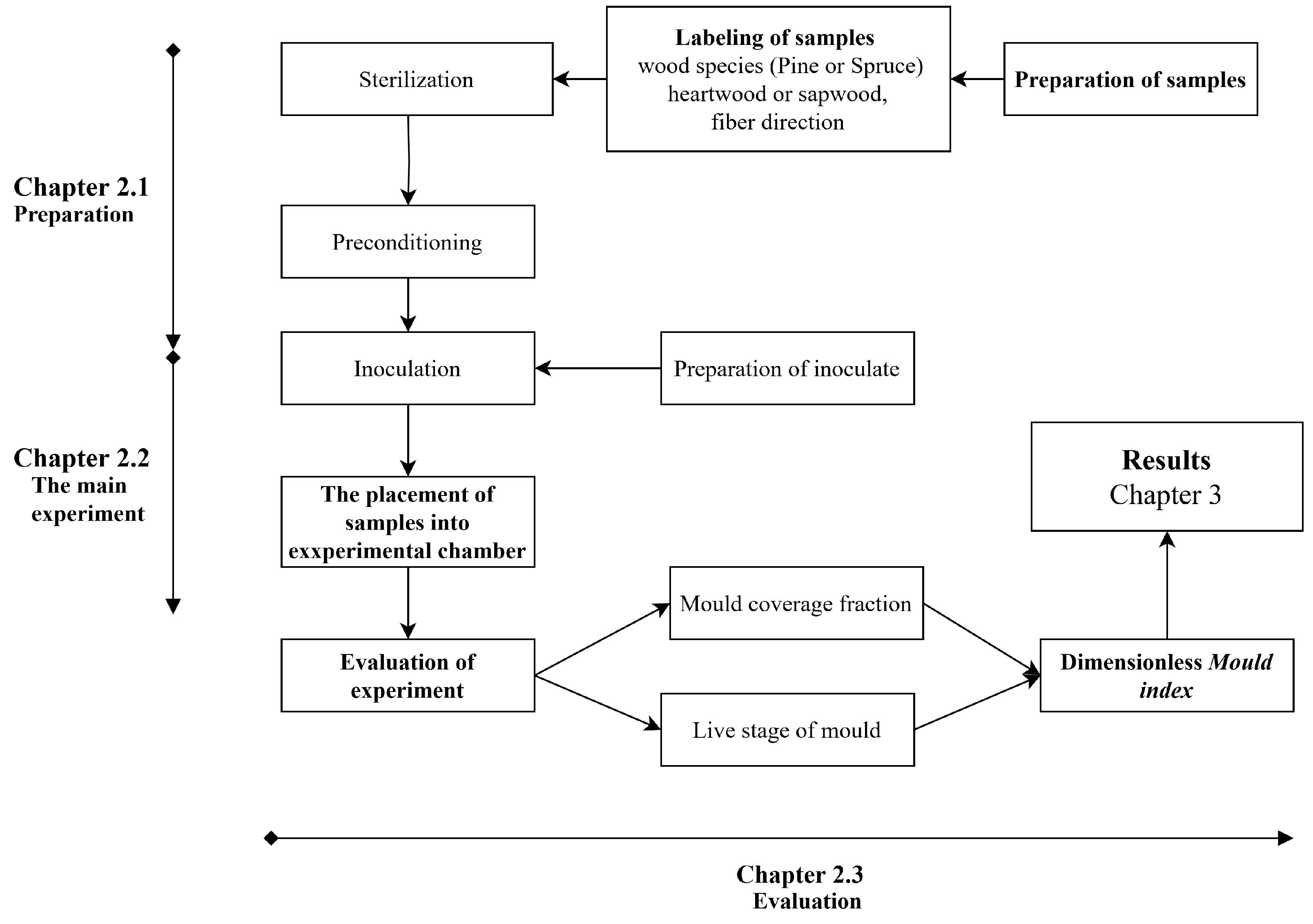
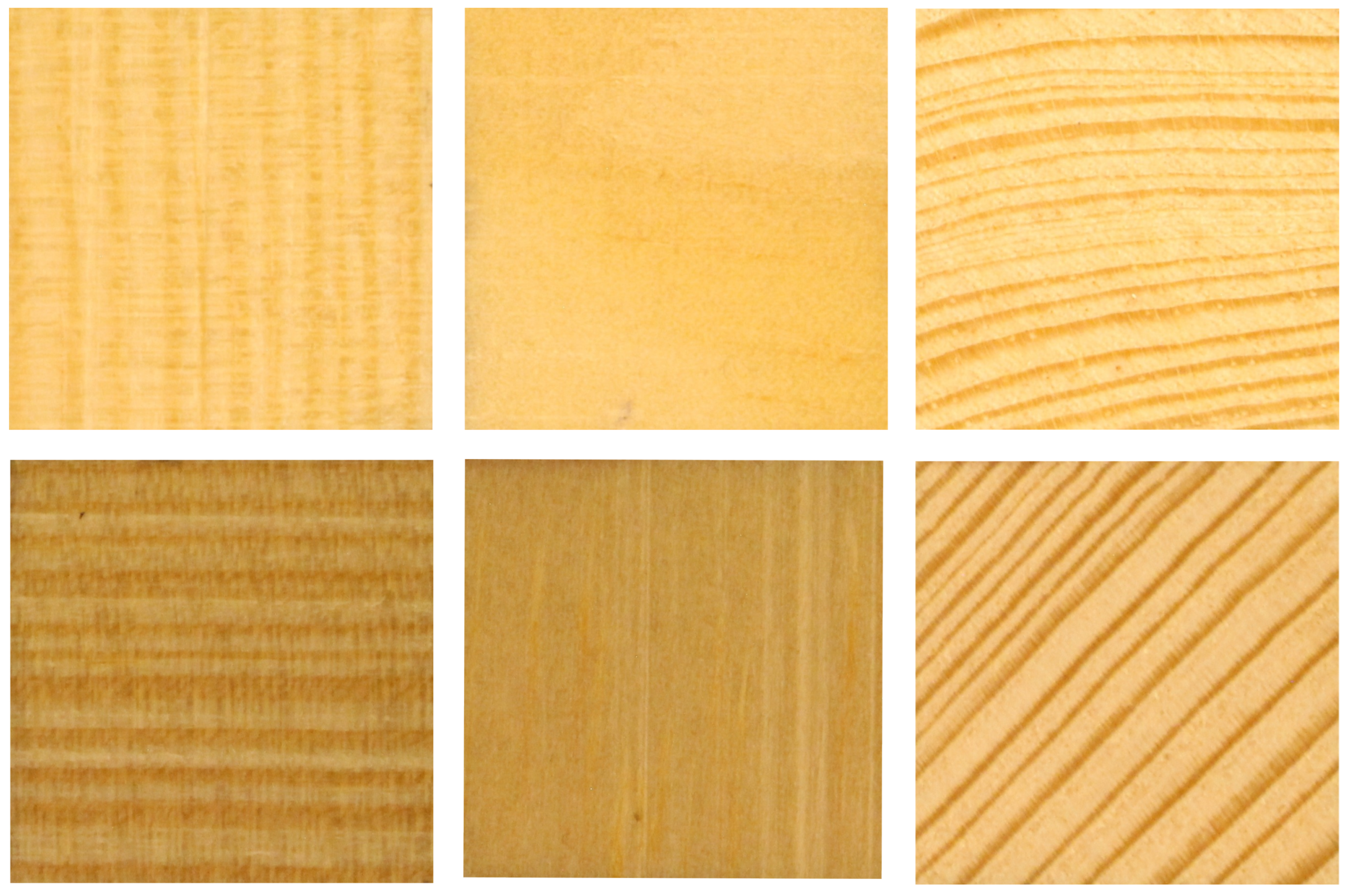
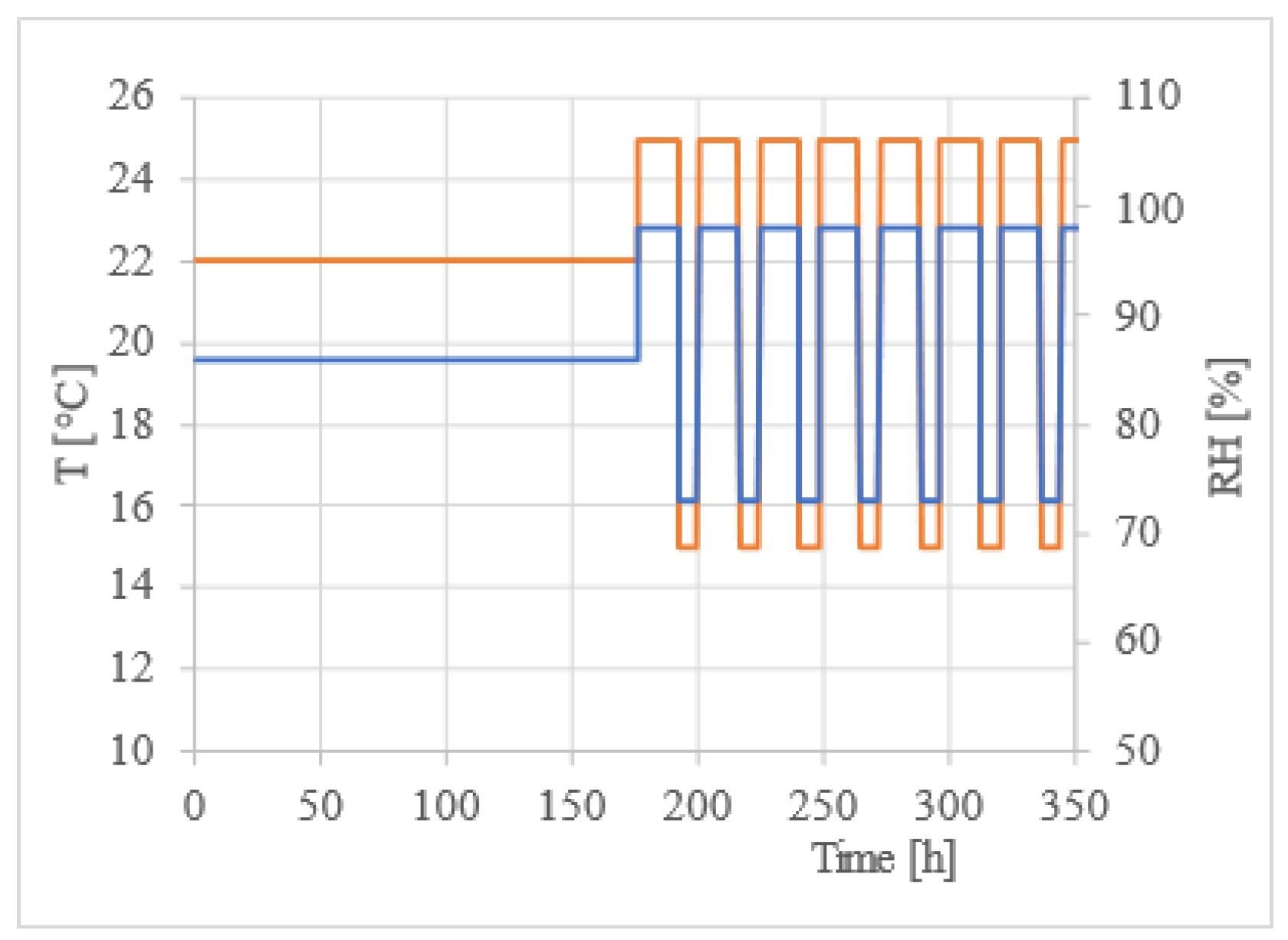

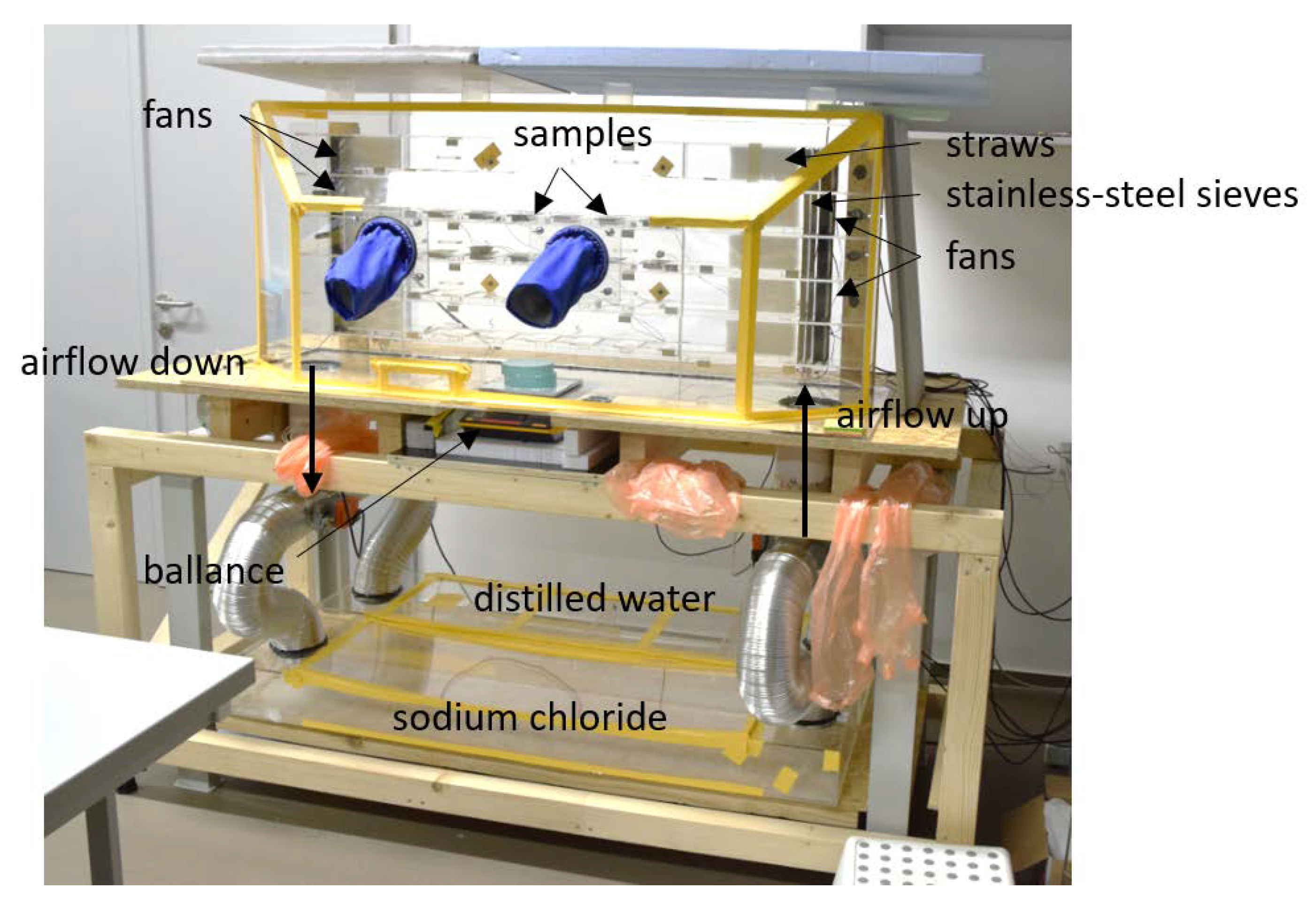

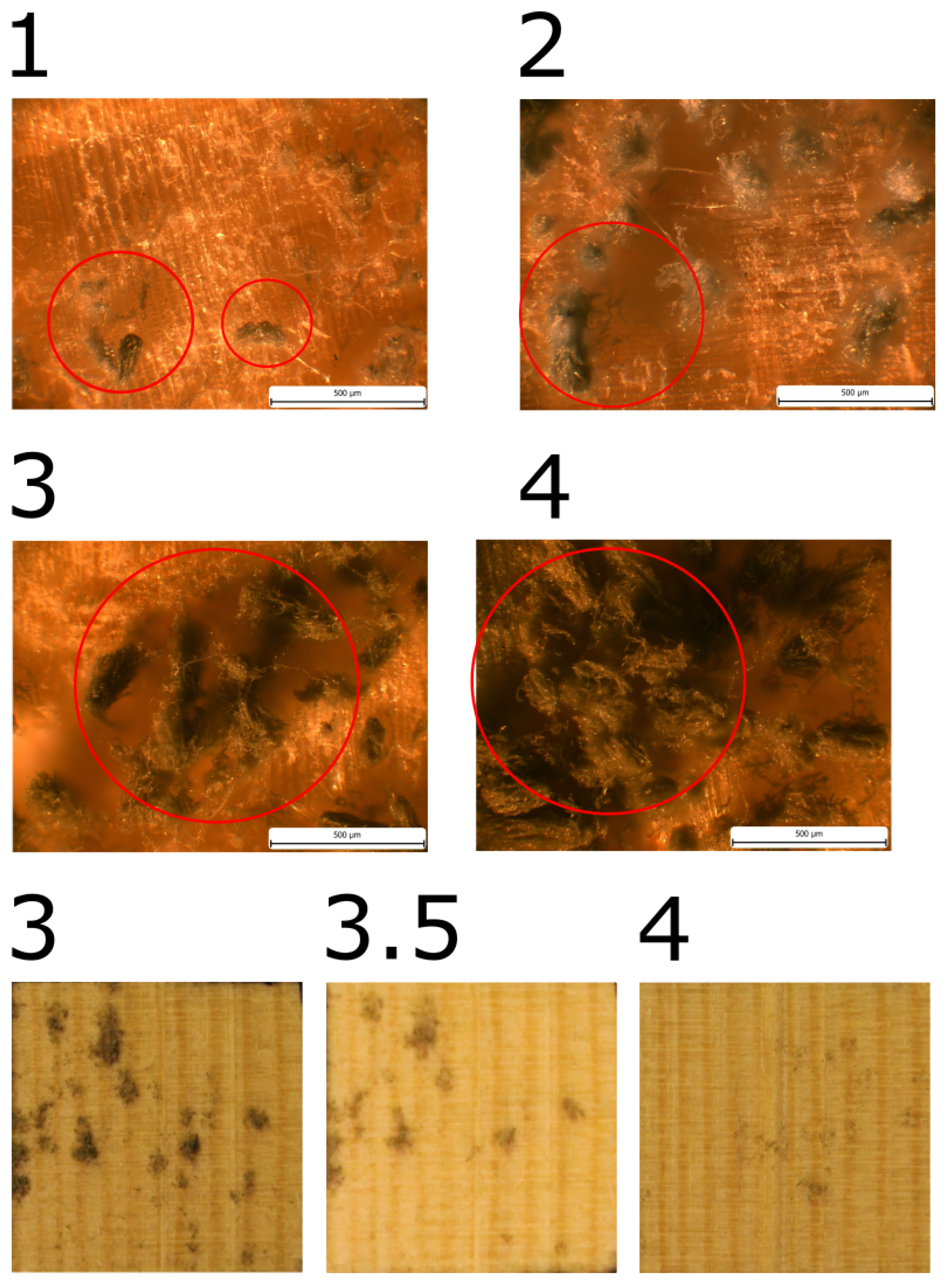


| Tree Species | Direction of Wood Fiber | Nomenclature | Amount |
|---|---|---|---|
| Pine—Sapwood | Tangential surface | 6 | |
| Radial surface | 6 | ||
| Transversal surface | 6 | ||
| Pine—Heartwood | Tangential surface | 6 | |
| Radial surface | 6 | ||
| Transversal surface | 6 | ||
| Spruce—Sapwood | Tangential surface | 6 | |
| Radial surface | 6 | ||
| Transversal surface | 6 | ||
| Spruce—Heartwood | Tangential surface | 6 | |
| Radial surface | 6 | ||
| Transversal surface | 6 |
| MI | SMI | Magnification of Observation | Description | |
|---|---|---|---|---|
| [-] | [-] | 40× | 1× | |
| 0 | 0 | 0 | 0 | No growth, only spores |
| 0.5 | 0.1–1 | Germination of spores | ||
| 1 | 1 | 1–5 | 1–5 | Initial growth, first visible hyphae |
| 1.5 | 5–10 | Initial growth hyphae clearly visible | ||
| 2 | - | 10–30 | Development of mycelium with first aerial hyphae, moulds are almost exclusively visible under a microscope | |
| 3 | 3 | 30–50 | 5–25 | Development of mycelium with sporangium, Moulds start visible macroscopically |
| 3.5 | 50–70 | 25–50 | Development of mycelium with sporangium, Moulds are visible macroscopically | |
| 4 | - | 70–90 | 50–70 | Decay of mould or huge sporulation |
| 90–100 | 70–100 | |||
| Magnification | MI by VTT | MI by Joh and Ryp | SMI by Ryp | |
|---|---|---|---|---|
| 40× | 1× | |||
| 0 | 0 | 0 | 0 | 0 |
| 0.1–1 | 1 | 0.5 | ||
| 1–5 | 1–5 | 1 | 1 | |
| 5–10 | 2 | 1.5 | ||
| 10–30 | 2 | - | ||
| 30–50 | 5–25 | 3 | 3 | 3 |
| 50–70 | 25–50 | 4 | 3.5 | |
| 70–90 | 50–70 | 5 | 4 | 4 |
| 90–100 | 70–100 | 6 | ||
| Samples MI [-]/Time [day] | PST | PSX | PSR | PSRa |
|---|---|---|---|---|
| 1 | 76.25 | 77.75 | 76 | 27 |
| 1.5 | - | - | 79 | 45.7 |
| 2 | 81.3 | 79.5 | 82 | 69 |
| 3 | 90.8 | 92.3 | 89.7 | 79 |
| 3.5 | 120 | 101.5 | 110 | 101 |
| 4 | - | 103.3 | - | 143 |
| Samples MI [-]/ Time [day] | SST | SSX | SSR |
|---|---|---|---|
| 1 | 70 | - | 72 |
| 1.5 | 91 | - | 98 |
| 2 | 110 | - | 120 |
| 3 | - | - | - |
| 3.5 | - | - | - |
| 4 | - | - | - |
Disclaimer/Publisher’s Note: The statements, opinions and data contained in all publications are solely those of the individual author(s) and contributor(s) and not of MDPI and/or the editor(s). MDPI and/or the editor(s) disclaim responsibility for any injury to people or property resulting from any ideas, methods, instructions or products referred to in the content. |
© 2024 by the authors. Licensee MDPI, Basel, Switzerland. This article is an open access article distributed under the terms and conditions of the Creative Commons Attribution (CC BY) license (https://creativecommons.org/licenses/by/4.0/).
Share and Cite
Ryparová, P.; Rácová, Z. Characteristics of Mould Growth in Pine and Spruce Sapwood and Heartwood under Fluctuating Humidity. Appl. Sci. 2024, 14, 8417. https://doi.org/10.3390/app14188417
Ryparová P, Rácová Z. Characteristics of Mould Growth in Pine and Spruce Sapwood and Heartwood under Fluctuating Humidity. Applied Sciences. 2024; 14(18):8417. https://doi.org/10.3390/app14188417
Chicago/Turabian StyleRyparová, Pavla, and Zuzana Rácová. 2024. "Characteristics of Mould Growth in Pine and Spruce Sapwood and Heartwood under Fluctuating Humidity" Applied Sciences 14, no. 18: 8417. https://doi.org/10.3390/app14188417
APA StyleRyparová, P., & Rácová, Z. (2024). Characteristics of Mould Growth in Pine and Spruce Sapwood and Heartwood under Fluctuating Humidity. Applied Sciences, 14(18), 8417. https://doi.org/10.3390/app14188417






